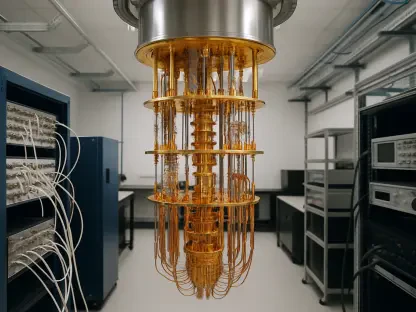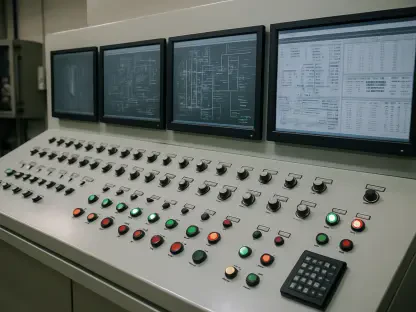What happens when the backbone of modern technology—data centers—can no longer keep pace with the relentless demands of artificial intelligence? In an era where AI drives everything from autonomous vehicles to personalized healthcare, the infrastructure supporting these innovations faces unprecedented strain, with sprawling facilities packed with servers struggling to process massive datasets for machine learning models, often hitting bottlenecks that delay breakthroughs. This pressing challenge sets the stage for a transformative solution that could redefine how computational power is harnessed for the AI age.
The significance of this issue cannot be overstated. As AI workloads grow exponentially, traditional server-centric data centers are proving inadequate, leading to inefficiencies, soaring costs, and stalled progress in critical fields. Enter rack-scale computing, an innovative approach that shifts the focus from individual servers to entire racks as the core unit of resource management. This paradigm promises not only to address current limitations but also to pave the way for scalable, high-performance infrastructure tailored to the unique needs of AI applications. Exploring this shift reveals why it stands as a cornerstone for the future of technology.
The Crushing Weight of AI Demands on Data Centers
Data centers, once designed for predictable workloads, now grapple with the sheer intensity of AI-driven tasks. Machine learning algorithms, generative models, and real-time data analytics require computational resources far beyond what conventional setups can provide. Reports indicate that AI workloads can demand up to 10 times the power and cooling of traditional applications, exposing the fragility of server-by-server architectures in handling such scale.
This mismatch creates cascading problems across industries. Delays in processing power hinder advancements in sectors like medical research, where AI models for drug discovery need rapid iterations. Operational costs also skyrocket as facilities strain to maintain uptime under extreme loads, with some estimates suggesting a 30% increase in energy expenses for AI-heavy data centers over the past two years. These challenges underscore an urgent need for a structural overhaul in how resources are allocated and optimized.
AI’s Insatiable Hunger Sparks a New Infrastructure Era
The rapid ascent of AI has reshaped the technological landscape, pushing data centers into uncharted territory. Unlike past computing trends, AI requires seamless integration of vast compute, memory, and storage capacities to function effectively. Traditional designs, often fragmented across individual servers, falter under this pressure, unable to deliver the synchronized performance necessary for cutting-edge applications.
This reality impacts real-world progress in tangible ways. Businesses aiming to deploy AI for customer insights face bottlenecks that slow market responsiveness, while researchers working on climate modeling encounter hardware limitations that impede critical simulations. The financial burden is equally stark, with infrastructure upgrades sometimes costing millions without guaranteed returns. A fundamental shift toward a more cohesive and powerful framework is no longer optional but imperative for sustaining innovation.
Decoding Rack-Scale Computing: A Bold Leap for AI Power
At its core, rack-scale computing reimagines data center architecture by treating entire racks, rather than single servers, as the primary unit of operation. This approach allows for holistic resource allocation, where compute, storage, and networking components are configured to match specific AI workload demands. Such a design ensures that massive processing power is readily available without the fragmentation seen in older models.
The advantages are striking in their precision. Racks can be customized with high-speed switches for data-heavy tasks or advanced cooling systems to manage heat in densely packed environments, addressing pain points traditional setups often ignore. Modern innovations, such as racks capable of supporting up to 1 megawatt of hardware, demonstrate the ability to handle extreme densities required for AI processing, a feat showcased in leading-edge facilities worldwide.
This framework also fosters scalability in a way previously unattainable. By dedicating entire racks to specific projects, data centers can minimize latency and maximize throughput, ensuring that AI applications run without interruption. This tailored efficiency positions rack-scale computing as a game-changer, capable of meeting the relentless pace of technological advancement head-on.
Industry Pioneers Weigh In on the Rack-Scale Shift
Insights from thought leaders lend weight to the growing momentum behind rack-scale computing. At a prominent industry event this year, analyst Jeremie Eliahou Ontiveros highlighted its critical role, noting, “The computational intensity of AI leaves no room for outdated architectures—rack-scale designs are the backbone of tomorrow’s data centers.” Such perspectives reflect a broader consensus among experts that this shift is essential for progress.
Historical efforts by tech giants like Microsoft and Intel, dating back over a decade, laid early groundwork for these ideas, though widespread adoption lagged until AI emerged as a catalyst. Today, data center operators experimenting with high-capacity racks offer compelling anecdotes of transformation. One manager reported a 40% improvement in processing speeds for AI training models after transitioning to rack-level configurations, illustrating the practical impact of this approach on real-world challenges.
These voices collectively paint a picture of an industry at a turning point. With AI workloads as the driving force, rack-scale computing has evolved from a niche concept to a cornerstone strategy, backed by both innovation and firsthand evidence of its effectiveness. The conversation now centers on how quickly and widely this model can be embraced.
Charting the Path to Rack-Scale Adoption
For data center leaders navigating the complexities of AI demands, actionable strategies provide a roadmap to integrate rack-scale computing effectively. A starting point lies in assessing workload requirements to pinpoint AI tasks that would benefit most from dedicated rack resources, ensuring targeted investment. This step prevents over-allocation and focuses efforts on high-impact areas.
Investing in modular rack designs offers another practical avenue, allowing for flexible hardware customization based on evolving needs. Prioritizing high-capacity solutions, such as those supporting up to 1 megawatt of hardware, addresses the density and power challenges inherent in AI applications. Additionally, enhancing monitoring systems to track performance metrics like heat dissipation and data flow helps preempt bottlenecks, maintaining seamless operation.
Collaboration with hardware vendors and industry peers can further streamline this transition. By sharing insights on best practices and emerging technologies, data center managers can build resilient, future-proof infrastructures. These steps collectively empower organizations to harness rack-scale computing, aligning their capabilities with the relentless trajectory of AI innovation.
Reflecting on a Transformative Journey
Looking back, the journey toward rack-scale computing unfolded as a response to an era defined by AI’s unyielding demands. Data centers, once anchored by individual servers, adapted to a reality where entire racks became the new standard for resource management. This evolution tackled inefficiencies and bottlenecks that had slowed progress, offering a lifeline to industries reliant on computational power.
The voices of experts and operators alike echoed a shared conviction that this shift was inevitable, driven by the need for customized, high-capacity solutions. Stories of improved processing speeds and reduced operational strain stood as testaments to the impact of this approach. For those yet to embark on this path, the next steps involved rigorous assessment of needs and strategic investments in scalable designs.
Beyond immediate actions, the broader consideration remained clear: staying ahead in the AI landscape demanded continuous adaptation. Exploring partnerships, testing new rack configurations, and prioritizing monitoring tools emerged as vital moves to sustain momentum. This reflective moment underscored that embracing rack-scale computing was not just a fix for past struggles but a foundation for future triumphs.









